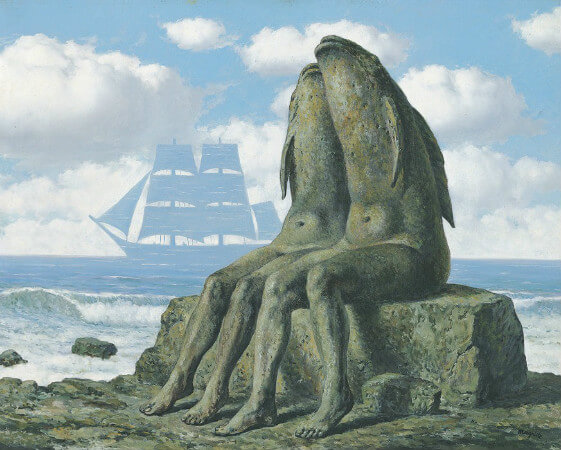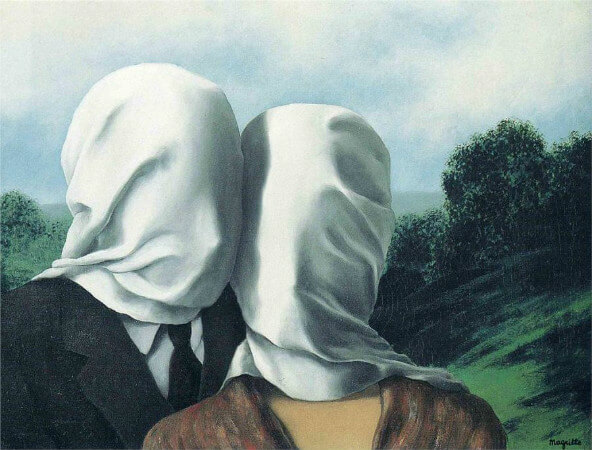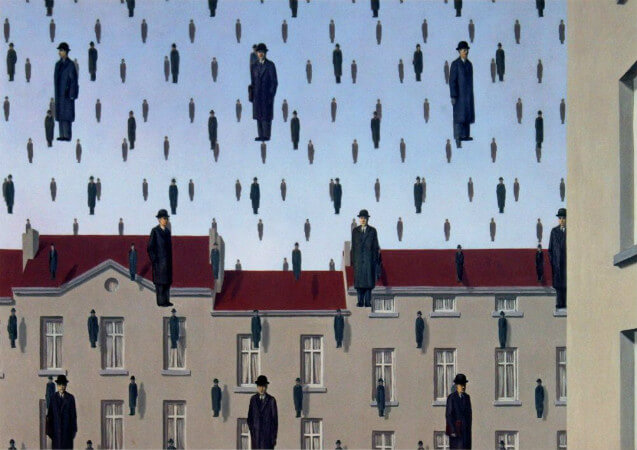Painter of mystery and surreal poetry: Who is Rene Magritte?
His mother commits suicide by jumping into the river. The fact that his mother was later found with a veil on his face caused Magritte to be unable to get rid of the influence of this image throughout his life and to frequently use veiled figures and river depictions in his paintings.

René Magritte, the famous surrealist painter, was born on 21 November 1898 in Lessines, Belgium. René Magritte is the eldest child in the family. His father is a merchant, so they change cities often.
While they were living in Châtelet, on March 12, 1912, his mother committed suicide by jumping into the Sambre River. The fact that his mother was later found with a veil on his face caused Magritte to be unable to get rid of the influence of this image throughout his life and to frequently use veiled figures and river depictions in his paintings.
René François Ghislain Magritte ( 21 November 1898 – 15 August 1967) was a Belgian surrealist artist known for his depictions of familiar objects in unfamiliar, unexpected contexts, which often provoked questions about the nature and boundaries of reality and representation. His imagery has influenced pop art, minimalist art, and conceptual art.
In the same year, his family moves to the city of Charleroi. At the age of 15, Magritte meets 13-year-old Georgette Berger, who would later become his wife, at the Charleroi fair, and he is almost fascinated. Although he did not see it for many years, it is engraved in his memory as an unforgettable dream of his early youth years.

It is seen that the artist, who started his art education at the Brussels Academy of Fine Arts between 1917-1918, produced products in different schools in different periods of his life.
Sharing the same workshop with Pierre-Louis Flouquet, one of his teachers, who was very impressed while at the Academy, Magritte gave his futuristic and cubic works during this period. While Magritte's search for the post-Academy continues, he tries various abstract paintings with Victor Servranckx, but soon realizes that this is not his goal. In the same year, he meets the paintings of Giorgio de Chirico, who will completely changes his understanding of art.
1925 was a period when he increased his professionalism and devoted all his time to painting. The abstractions and simplifications he makes on objects in his paintings are replaced by meticulous detail. It aims to challenge the real world by painting objects in positions that the viewer is not accustomed to. One of the first works reflecting this change in his art is his painting Nocturne.
It was followed by Reflections of the Hermit Traveller, dated 1926, The Threat of Assault, and The Lost Jockey, considered his first surreal work. These paintings are the first examples of Magritte's established style and contain early depictions of many of the images that he will continually use in his paintings.
As it is known, surrealism emerged as an uprising against the disasters of the First World War. This movement, which manifests itself in all branches of art, adopts harsh, surprising, and shocking language. It does not accept the understanding of aestheticism and beautiful painting. Magritte, who settled in Paris between 1927-1930, expanded his art circle during this time and met surrealist artists such as André Breton, Louis Aragon, Max Ernst, and Salvador Dali.
René Magritte diversifies the different perspectives he brought to surrealism with the richness of his style. He develops a philosophical style by integrating with the theme of mystery that constitutes the essence of his art. It is observed that Magritte always acts with rational logic, in contrast to the unconscious or completely left to emotions, and the somewhat coincidental approaches of the surrealists. Undoubtedly, the effect of his closeness to philosophy can be seen in his rational approaches. Hegel, Martin Heidegger, Jean-Paul Sartre, and Michel Foucault can be given as examples of the philosophers he was particularly interested in. It is seen that he read the texts and books of these philosophers and benefited from this thought pattern in his art.

In his paintings titled Lovers, Magritte depicts a man and a woman covered with white cloth. One of the paintings shows a man and a woman cheek to cheek in front of a landscape of blue sky and forest. In the other, the man and woman are kissing in a room. In Magritte's imagination, there are two views on how the image of the veiled face can be given meaning. Like many of his surrealist friends, Magritte may have been influenced by Fantôma, the hero of the shadows, who first appeared in suspense novels in 1913. Fantôma is a 43-volume book series co-written by Pierre Souvestre and Marcel Allain between 1912 and 1914. Fantôma is an anti-hero, his identity is always hidden because he has a sock or piece of cloth on his head.
Another source may have crept in from his own life. At the age of 14, the artist suffered great trauma when his mother jumped into the river near their house, and the traces of this event will be seen in his later paintings. The only thing he remembers about his childhood is the lifeless body of his mother, covered with a sheet. Regardless of where Magritte took his inspiration, the veiled faces of the men and women in the paintings carry an air of distress and suffocation, even if they share a happy action.
Magritte created his works from everyday, simple objects and changed their functions by using objects with certain uses in completely different ways. A bird with blue spots and clouds, a man in a hooded hat, turbulent facial expressions, a rose, apples that fill the whole room and become giants, a different-sized image of a man, shoes, whatnot, trees, windows, door, chair, table, pipe, brushes, He took the images of very ordinary objects such as flower pots out of their natural appearance and revealed them in an astonishing and imaginary environment, contrary to logic and reason, and changed the dimensions of the participants of timeless life.
In 1936 Magritte goes to London and meets and falls in love with Sheila Legg, called the Surrealist Phantom in Dali's work. During this period, he is separated from his wife, Georgette, and informs his friend Paul Colinet to take care of him, but during this time there is a rapprochement between his wife and Paul. Georgette announces that she wants a divorce from René. In 1940, Georgette and René are now separated, and in May 1940 the Nazis occupy Brussels. René is forced to go to France, leaving behind his home and the woman he loves.
Trying to hold on in Europe during the war years, Magritte goes through a difficult period in every sense. The artist, who went to Carcassonne in the south of France, made the first of his transformation works based on the leaf figure in order to emphasize the freshness and beauty of life, Treasure Island, which he made in 1942. He also does other work using this theme. Magritte became briefly involved with the Belgian Communist Party in 1945. He also participated in the actions of the revolutionary surrealists between 1946-48.
Magritte emphasizes the objective presentation of objects. Maybe he advocates that the image speaks for itself, with the effect of having worked in the advertising world, and that the artist should come out as little as possible. Because Magritte worked first in a wallpaper factory and later as a poster and advertising designer until 1926 when he signed an agreement with the Galerie Le Centaure in Brussels that allowed him to draw full-time. Although his paintings are often described as realistic, they carry surreal poetry and mystery. This poetry and mystery arise from the unanswerable questions or riddles that the painter puts before us in his works.
He also uses some of the themes he used in his paintings shortly before his death in his sculpture drawings designed in a surrealistic style. After his death, these designs were turned into bronze sculptures and exhibited in Paris. René François Ghislain Magritte died in Brussels on August 15, 1967.
